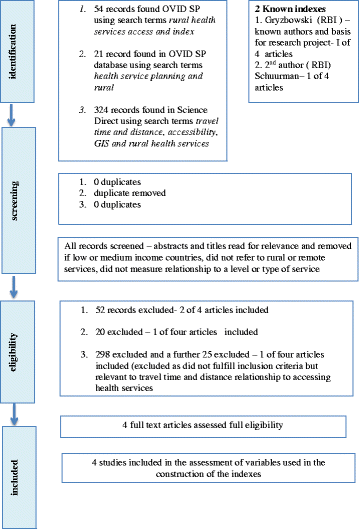A review of rural and remote health service indexes: are they relevant for the development of an Australian rural birth index?
- PMID: 25491346
- PMCID: PMC4265404
- DOI: 10.1186/s12913-014-0548-7
A review of rural and remote health service indexes: are they relevant for the development of an Australian rural birth index?
Abstract
Background: Policy informs the planning and delivery of rural and remote maternity services and influences the perinatal outcomes of the 30 per cent of Australian women and their babies who live outside the major cities. Currently however, there are no planning tools that identify the optimal level of birthing services for rural and remote communities in Australia. To address this, the Australian government has prioritised the development of a rigorous methodology in the Australian National Maternity Services Plan to inform the planning of rural and remote maternity services.
Methods: A review of the literature was undertaken to identify planning indexes with component variables as outlined in the Australian National Maternity Services Plan. The indexes were also relevant if they described need associated with a specific type and level of health service in rural and remote areas of high income countries. Only indexes that modelled a range of socioeconomic and or geographical variables, identified access or need for a specific service type in rural and remote communities were included in the review.
Results: Four indexes, two Australian and two Canadian met the inclusion criteria. They used combinations of variables including: geographical placement of services; isolation from services and socioeconomic vulnerability to identify access to a type and level of health service in rural and remote areas within 60 minutes. Where geographic isolation reduces access to services for high needs populations, additional measures of disadvantage including indigeneity could strengthen vulnerability scores.
Conclusion: Current planning indexes are applicable for the development of an Australian rural birthing index. The variables in each of the indexes were relevant, however use of flexible sized catchments to accurately account for population births and weighting for extreme geographic isolation needs to be considered. Additionally, socioeconomic variables are required that will reflect need for services particularly for isolated high needs populations. These variables could be used with Australian data and appropriate cut-off points to confirm applicability for maternity services. All of the indexes used similar types of variables and are relevant for the development of an Australian Rural Birth Index.
Figures
Similar articles
-
The distribution of maternity services across rural and remote Australia: does it reflect population need?BMC Health Serv Res. 2017 Feb 23;17(1):163. doi: 10.1186/s12913-017-2084-8. BMC Health Serv Res. 2017. PMID: 28231830 Free PMC article.
-
Beyond the black stump: rapid reviews of health research issues affecting regional, rural and remote Australia.Med J Aust. 2020 Dec;213 Suppl 11:S3-S32.e1. doi: 10.5694/mja2.50881. Med J Aust. 2020. PMID: 33314144
-
Identifying maternity services in public hospitals in rural and remote Australia.Aust Health Rev. 2014 Jun;38(3):337-44. doi: 10.1071/AH13188. Aust Health Rev. 2014. PMID: 24882523
-
A systematic integrative review examining the impact of Australian rural and remote maternity unit closures.Midwifery. 2021 Dec;103:103094. doi: 10.1016/j.midw.2021.103094. Epub 2021 Jul 14. Midwifery. 2021. PMID: 34329966
-
Hospitals in rural or remote areas: An exploratory review of policies in 8 high-income countries.Health Policy. 2016 Jul;120(7):758-69. doi: 10.1016/j.healthpol.2016.05.011. Epub 2016 Jun 6. Health Policy. 2016. PMID: 27312144 Review.
Cited by
-
Estimating the local spatio-temporal distribution of malaria from routine health information systems in areas of low health care access and reporting.Int J Health Geogr. 2021 Feb 12;20(1):8. doi: 10.1186/s12942-021-00262-4. Int J Health Geogr. 2021. PMID: 33579294 Free PMC article.
-
Improving geographical accessibility modeling for operational use by local health actors.Int J Health Geogr. 2020 Jul 6;19(1):27. doi: 10.1186/s12942-020-00220-6. Int J Health Geogr. 2020. PMID: 32631348 Free PMC article.
-
The distribution of maternity services across rural and remote Australia: does it reflect population need?BMC Health Serv Res. 2017 Feb 23;17(1):163. doi: 10.1186/s12913-017-2084-8. BMC Health Serv Res. 2017. PMID: 28231830 Free PMC article.
-
Cost-effectiveness of continuity of midwifery care for women with complex pregnancy: a structured review of the literature.Health Econ Rev. 2018 Dec 5;8(1):32. doi: 10.1186/s13561-018-0217-3. Health Econ Rev. 2018. PMID: 30519755 Free PMC article. Review.
-
Geographic barriers to achieving universal health coverage: evidence from rural Madagascar.Health Policy Plan. 2021 Nov 11;36(10):1659-1670. doi: 10.1093/heapol/czab087. Health Policy Plan. 2021. PMID: 34331066 Free PMC article.
References
-
- Li Z, Zeki R, Hilder L, Sullivan EA. Perinatal Statistics Series no 27 CAT no PER 57. Canberra: AIHW National Perinatal Epidemiology and Statistics Unit; 2012. Australia’s Mothers and Babies 2010.
-
- Arnold JL, de Costa CM, Howat PW. Timing of transfer for pregnant women from Queensland Cape York communities to Cairns for birthing. Med J Aust. 2009;190(10):594–596. - PubMed
Publication types
MeSH terms
LinkOut - more resources
Full Text Sources
Other Literature Sources
Medical
Miscellaneous


